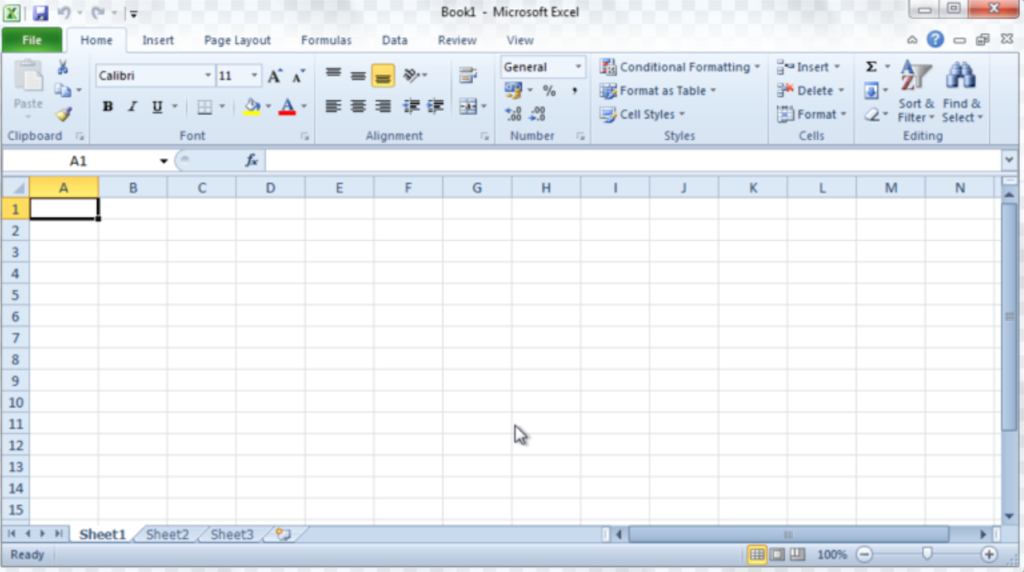Introduction
Microsoft Excel, the ubiquitous spreadsheet software that has become an essential tool for businesses, students, and professionals worldwide, has a rich history that spans over three decades. From its inception as a simple data management tool to its current status as a powerful platform for data analysis and visualization, Excel’s journey is a testament to Microsoft’s commitment to innovation and user needs.
Excel’s story began in 1985 with the introduction of Microsoft Multiplan for Apple Macintosh computers1. However, it was the rebranding of Multiplan to Microsoft Excel in 1987 that marked the true birth of the spreadsheet giant. This new version boasted an improved user interface, extended capabilities, and compatibility with the Windows operating system, setting the stage for future developments.
Excel 1.0 was launched by Microsoft in 1985 for an Apple Macintosh. It was not until 1987 that Microsoft published Excel 2.0 for MS-DOS. In truth, Excel was included with Windows 2.0, and the program ate up all the office system’s RAM. Over the next several years, Excel and Lotus 1-2-3 competed, neck in neck.

In November of 1990, Microsoft Office was released. The first edition of the package included PowerPoint 2.0, Word (1.1), and Excel (2.0). According to the October 1, 1990, issue of the magazine Information World, “all three apps include support for Data Dynamic Exchange (DDE), which allows programs to transfer information in near real-time by using Windows resources”. This implies that the three apps will talk to one another, enabling the establishment of a digital Office.
When shopping for a gadget, many people question if the hardware will help them plan or whether it will end up in the garbage. Microsoft released Windows (3.1) in 1992, which increased graphical usability and included Program Manager, a new file system interface.
Therefore, it is no surprise that it became the most frequently used operating system on IBM PCs almost immediately after its release. Offices were among the first to adopt Windows because it was and would continue to be compatible with the programs they already had. Microsoft Office was compatible with all major computers, yet it was only available for Mac users (OS). In the early 1990s, however, Apple’s corporate image suffered.

Excel had been updated four times when Windows 95 and Excel 95 were released. This had already overtaken Lotus (1-2-3), likewise having trouble adjusting to Windows’ capability.
At the time, IBM was seeking to offer a Windows-based application software program called Lotus SmartSuite. Lotus 1-2-3 was also recommended for IBM’s operating system (OS/2). Consequently, Microsoft refused to let IBM’s manufacturing division pre-install Windows 95 on retail PCs until just before its release.
IBM’s Lotus (SmartSuite) failed to endure a decade despite being one of the first great applications. Microsoft Office also contains Access, Outlook, Publisher, Skype and the other three services.

They learned something from the first time Lotus decimated Multiplan, mostly in the market. It sets them on the path to developing excellent app bundles that will help businesses worldwide. This led them down the path of creating a very good operating framework to put it all together. Because of previous economic failures, Microsoft has revolutionized how society does business.
Microsoft Excel Versions
Excel 2.0 was the first version of Excel for the Intel platform. Versions prior to 2.0 were only available for the Apple Macintosh.
Excel 2.0 (1987)
The first Windows version was labeled “2” to correspond to the Mac version. It was announced on October 6, 1987, and released on November 19. This included a run-time version of Windows.
Excel 3.0 (1990)
This version Included toolbars, drawing capabilities, outlining, add-in support, 3D charts, and many more new features.
Excel 4.0 (1992)
Version 4.0 Introduced a powerful feature called auto-fill. This feature automatically entered data into cells based on a pattern or criteria.
Also, an easter egg in Excel 4.0 reveals a hidden animation of a dancing set of numbers 1 through 3, representing Lotus 1-2-3, which is then crushed by an Excel logo.
Excel 5.0 (1993)
With version 5.0, Excel included Visual Basic for Applications (VBA), a programming language based on Visual Basic which adds the ability to automate tasks in Excel and to provide user-defined functions (UDF) for use in worksheets. VBA includes a fully featured integrated development environment (IDE). Macro recording can produce VBA code replicating user actions, thus allowing simple automation of regular tasks. VBA allows the creation of forms and in‑worksheet controls to communicate with the user. The language supports use (but not creation) of ActiveX (COM) DLL’s; later versions add support for class modules allowing the use of basic object-oriented programming techniques.
The automation functionality provided by VBA made Excel a target for macro viruses. This caused serious problems until antivirus products began to detect these viruses. Microsoft belatedly took steps to prevent the misuse by adding the ability to disable macros completely, to enable macros when opening a workbook or to trust all macros signed using a trusted certificate.
5.0 was released in a 16-bit x86 version for Windows 3.1 and later in a 32-bit version for NT 3.51 (x86/Alpha/PowerPC)
Versions 5.0 to 9.0 of Excel contained various Easter eggs, including a “Hall of Tortured Souls”, a Doom-like minigame.
Excel 95 (v7.0)

Released in 1995 with Microsoft Office for Windows 95, this is the first major version after Excel 5.0, as there is no Excel 6.0 with all of the Office applications standardizing on the same major version number.
Internal rewrite to 32-bits. Almost no external changes, but faster and more stable.
Excel 97 (v8.0)
Included in Office 97 (for x86 and Alpha). This was a major upgrade that introduced the paper clip office assistant and featured standard VBA used instead of internal Excel Basic. It introduced the now-removed Natural Language labels.
This version of Excel includes a flight simulator as an Easter egg.
Excel 2000 (v9.0)

Included in Office 2000. This was a minor upgrade but introduced an upgrade to the clipboard where it can hold multiple objects at once. The Office Assistant, whose frequent unsolicited appearance in Excel 97 had annoyed many users, became less intrusive.
A small 3-D game called “Dev Hunter” (inspired by Spy Hunter) was included as an Easter egg.
Excel 2002 (v10.0)
Included in Office XP. Very minor enhancements.
Version 10 of Excel marks the point at which Microsoft took measures to eliminate the so-called undocumented Easter eggs from their products.
Excel 2003 (v11.0)
Included in Office 2003. Minor enhancements.
Excel 2007 (v12.0)

This version was Included in Office 2007. This release was a major upgrade from the previous version. Similar to other updated Office products, Excel in 2007 used the new Ribbon menu system. This was different from what users were used to, and was met with mixed reactions. One study reported fairly good acceptance by users except for highly experienced users and users of word processing applications with a classical WIMP interface, but was less convinced in terms of efficiency and organization. However, an online survey reported that a majority of respondents had a negative opinion of the change, with advanced users being “somewhat more negative” than intermediate users, and users reporting a self-estimated reduction in productivity.
Added functionality included Tables, and the SmartArt set of editable business diagrams. Also added was an improved management of named variables through the Name Manager, and much-improved flexibility in formatting graphs, which allow (x, y) coordinate labeling and lines of arbitrary weight. Several improvements to pivot tables were introduced.
Also like other office products, the Office Open XML file formats were introduced, including .xlsm for a workbook with macros and .xlsx for a workbook without macros.
Specifically, many of the size limitations of previous versions were greatly increased. To illustrate, the number of rows was now 1,048,576 (220) and the columns were 16,384 (214; the far-right column is XFD). This changes what is a valid A1 reference versus a named range. This version made more extensive use of multiple cores for the calculation of spreadsheets; however, VBA macros are not handled in parallel and XLL add‑ins were only executed in parallel if they were thread-safe and this was indicated at registration.
Excel 2010 (v14.0)

Included in Office 2010, this is the next major version after v12.0, as version number 13 was skipped.
Minor enhancements and 64-bit support, including the following:
- Multi-threading recalculation (MTR) for commonly used functions
- Improved pivot tables
- More conditional formatting options
- Additional image editing capabilities
- In-cell charts called sparklines
- Ability to preview before pasting
- Office 2010 backstage feature for document-related tasks
- Ability to customize the Ribbon
- Many new formulas, most highly specialized to improve accuracy
Excel 2013 (v15.0)
Included in Office 2013, along with a lot of new tools included in this release:
- Improved Multi-threading and Memory Contention
- FlashFill
- Power View
- Power Pivot
- Timeline Slicer
- Windows App
- Inquire
- 50 new functions
Excel 2016 (v16.0)
Included in Office 2016, along with a lot of new tools included in this release:
- Power Query integration
- Read-only mode for Excel
- Keyboard access for Pivot Tables and Slicers in Excel
- New Chart Types
- Quick data linking in Visio
- Excel forecasting functions
- Support for multiselection of Slicer items using touch
- Time grouping and Pivot Chart Drill Down
- Excel data cards
Excel 2019, Excel 2021, Office 365 and subsequent (v16.0)
Microsoft no longer releases Office or Excel in discrete versions. Instead, features are introduced automatically over time using Windows Update. The version number remains 16.0. Thereafter only the approximate dates when features appear can now be given.
Summary
Today, Excel is more than just a spreadsheet program. It offers a versatile and comprehensive toolset for various purposes, including financial modeling, data visualization, and project management. The introduction of advanced data modeling capabilities with Power Pivot and Slicers, in-memory processing for improved calculation speeds, and real-time co-authoring through cloud-based Office 365 are just a few examples of Excel’s continuous evolution.
Microsoft Excel played a critical role in accounting and record-keeping for company operations in the days PC business computing was accessible. A table using auto sum format is one of the greatest examples of an MS Excel use case. Entering a column of data and clicking into a “cell” that is located at the lower side of the spreadsheet, then using the “auto sum” button to enable that cell for adding up all the numbers entered above, is very simple with Microsoft Excel. This replaced manual ledger counts, which were a time-consuming part of the business prior to the development of the current spreadsheet.
MS Excel has become a key component for various types of business computing, including having a look at daily, weekly, or monthly figures, tabulating payroll & taxes, and other similar business processes. Microsoft Excel has become an essential end-user technology, helpful in training & professional development. MS Excel has also been included in major business diplomas such as business computing for a couple of years, and now temporary job agencies may evaluate persons for a variety of clerical roles based on their proficiency in Microsoft Word & Microsoft Excel.
Microsoft Excel is used in every corner of personal and business life. From home budgets to business finances. From home recipe lists to business dashboards. It is the go-to tool for organizing and managing data and information. Excels history has had its ups and downs but has alway tried to travel in a direction that supports the user with tasks that either could not or would have been a challenge to perform manually.
Excel continues to evolve. Some have stated that Excel is obsolete in certain areas as business technology has progressed. This is due to an idea known as “visual dashboard” technology, often known as “data visualization”. In general, businesses and providers have devised innovative new methods to graphically show data that do not need end-users to examine a standard spreadsheet with columns that have listed numbers and IDs. Instead, they use graphs, charts, and other complex displays to better understand and comprehend the statistics. People have noticed that “reading” a visual presentation is much simpler. The application cases for MS Excel have been affected as a result of the data visualization concept.
The future of Excel is most likely in the arena of Cloud Computing and AI Integration. Looking ahead, the future of Excel is poised to leverage cloud computing and AI integration to enhance data analysis and efficiency. As Excel continues to evolve, it remains a testament to Microsoft’s dedication to providing tools that empower users to analyze, visualize, and make sense of data in an increasingly complex world1.
In conclusion, Microsoft Excel’s history is a narrative of constant growth and adaptation. From its humble beginnings to its current status as a powerhouse of data manipulation, Excel has proven to be an indispensable asset in the digital age. As we look forward to the innovations yet to come, one thing is certain: Excel will continue to shape the way we work with data for years to come.




